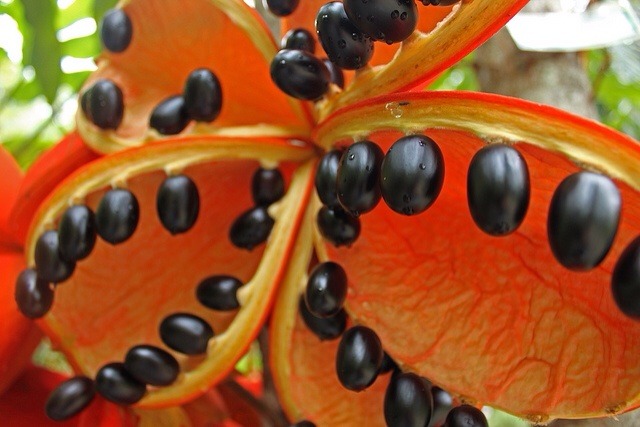Fruits are tasty and packed with nutrients. Regardless of who you are or where you are in the world, there will always be a fruit that you enjoy eating. One of the greatest things about fruits is the wide range of sizes, shapes, and especially flavors they offer. Some fruits are widely consumed around the world, such as apples, bananas, oranges, mangoes, among others. Besides these common fruits, there are numerous other unusual yet delicious fruits globally. We’ve compiled a list of 50 of the most unusual fruits from around the world. You may be surprised to see and learn about some of these fruits, so get ready to explore 50 of the most strange and unique fruits from across the globe.
Citrus Medica (Buddha’s Hand)
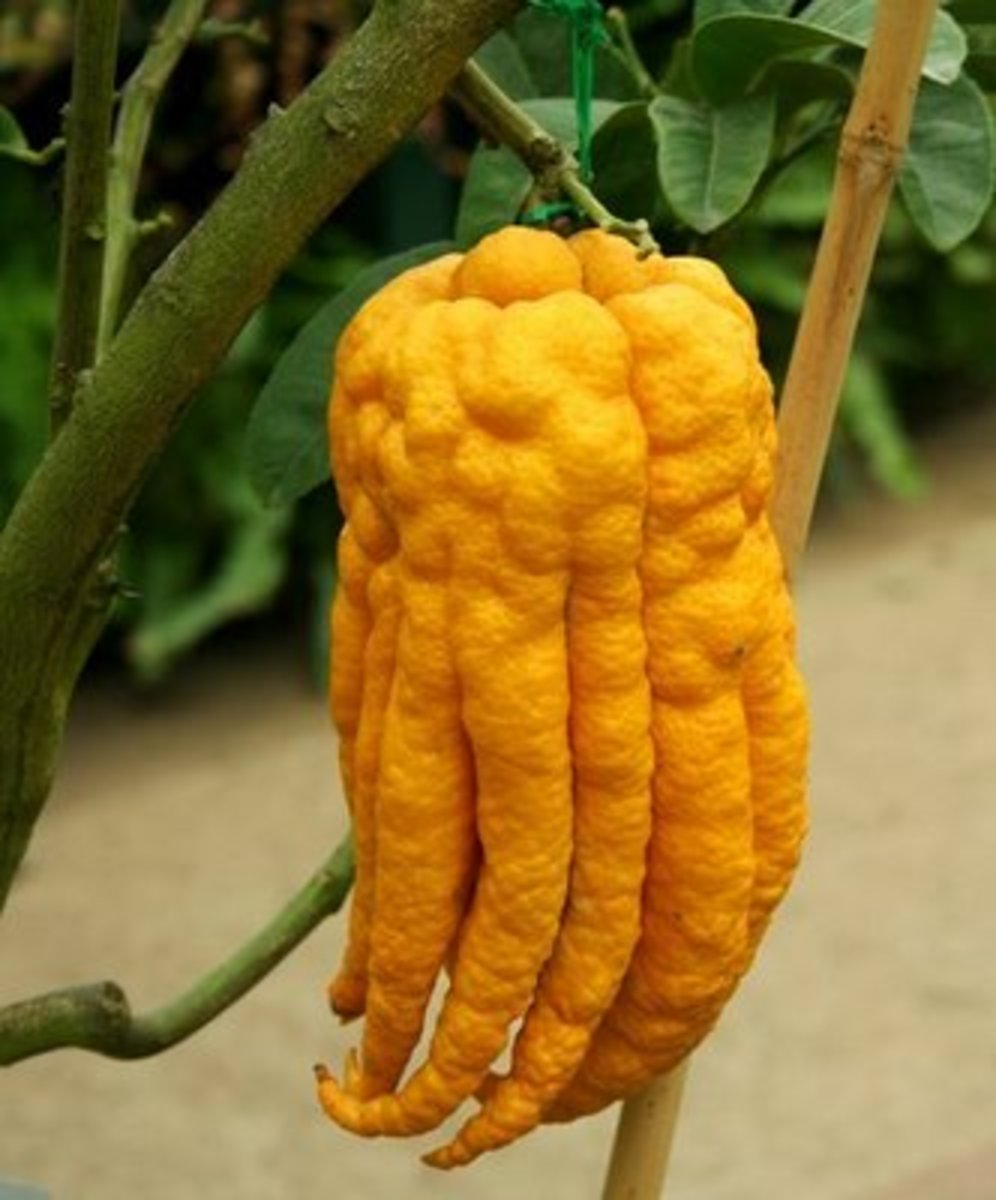
The reason this fruit has such a unique name is because it is actually shaped like a hand. The extensions from the bottom of the fruit closely resemble fingers. Buddha’s Hand is most commonly used in religious offerings, particularly because both the fruit and flowers have a refreshing fragrance. Although Buddha’s Hand is not typically eaten, some people enjoy incorporating it into their salads by cutting it into small cubes. If you preserve thin slices of the fruit, it can also be eaten as a healthy treat.
In Japan, Buddha’s Fingers are known as bushukan, and is often used as an air freshener or to scent clothing.
The fruit of the Hala, also known as the Puhala tree.
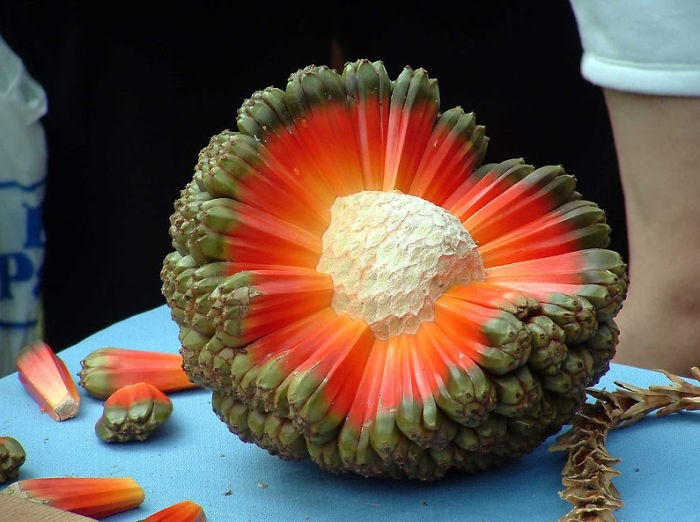
This fruit, which resembles a pineapple, naturally grows in the coastal areas of Malesia, eastern Australia, and the Pacific Islands. The fruit from the Hala tree, also known as pu Hala in Hawaiian, is produced by the female Pandanus tectorius tree. The large, ovoid fruit has a diameter of about 4-20 cm and typically appears in yellow, orange, and red colors with a green top. Both Pacific islanders and tourists enjoy various dishes made from the Hala fruit. The interior of each fruit segment is so pulpy and fibrous that it is widely used for making dental floss. For centuries, Hawaiian cultures have used the fruit as an aphrodisiac, dye, and medicine.
Monstera Deliciosa plant
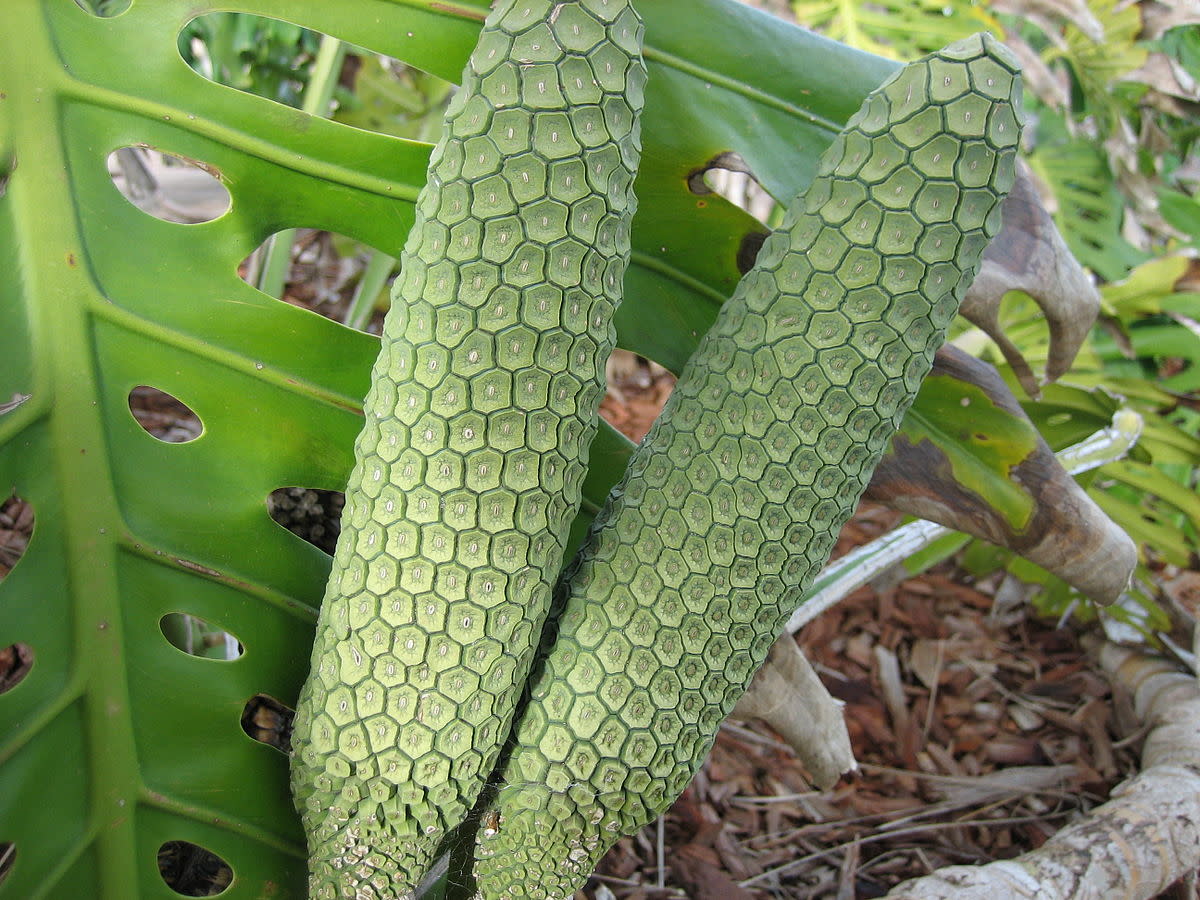
Commonly referred to as the Swiss Cheese Plant, this fruit, known as monstera, originates from Mexico. The fruit is elongated, similar to an ear of corn. The exterior is covered in hexagonal scales, which must be peeled away to access the flesh.
The most distinctive characteristic of the monstera fruit is its diverse array of flavors. It is sometimes called the “Fruit Salad Plant” because it seems to taste like many other delightful fruits. You might notice flavors reminiscent of strawberry, mango, passion fruit, and banana in this fruit.
Jaboticaba Fruit (Plinia Cauliflora)
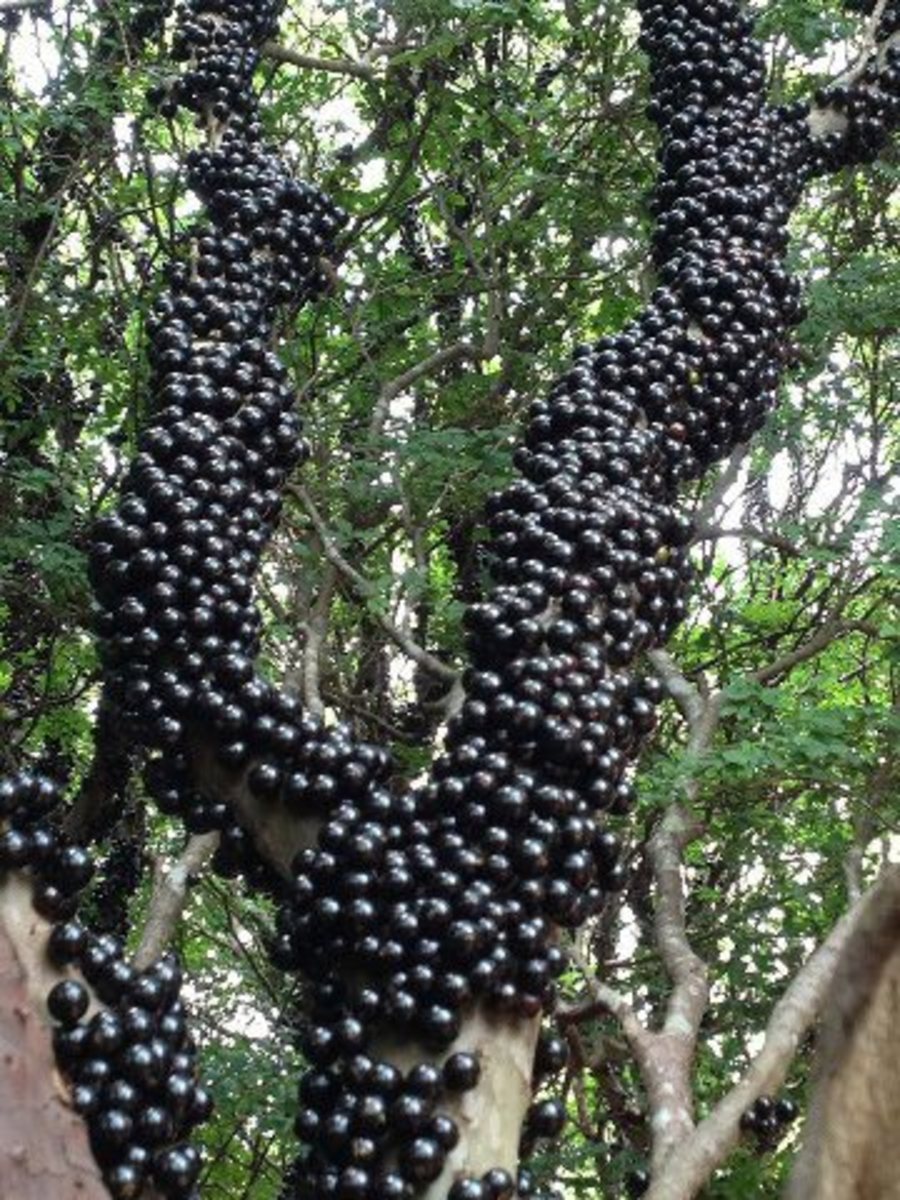
The jaboticaba fruit grows in a uniquely distinctive manner, directly from the tree’s trunk. Unlike most other fruits that typically emerge from flowers, the jaboticaba sets itself apart. If you ever encounter a Jaboticaba tree, you’ll be amazed by the numerous grapes attached to the branches and trunk. Additionally, this Brazilian fruit has purple and black skin with a texture similar to that of grapes. In some areas, the jaboticaba is known as Brazilian grapes.
Because the jaboticaba fruit resembles grapes, it shares similar uses. It can be eaten fresh, but it is often turned into jams, juices, or processed into wine.
The Akebi Fruit (Akebia Quinata)
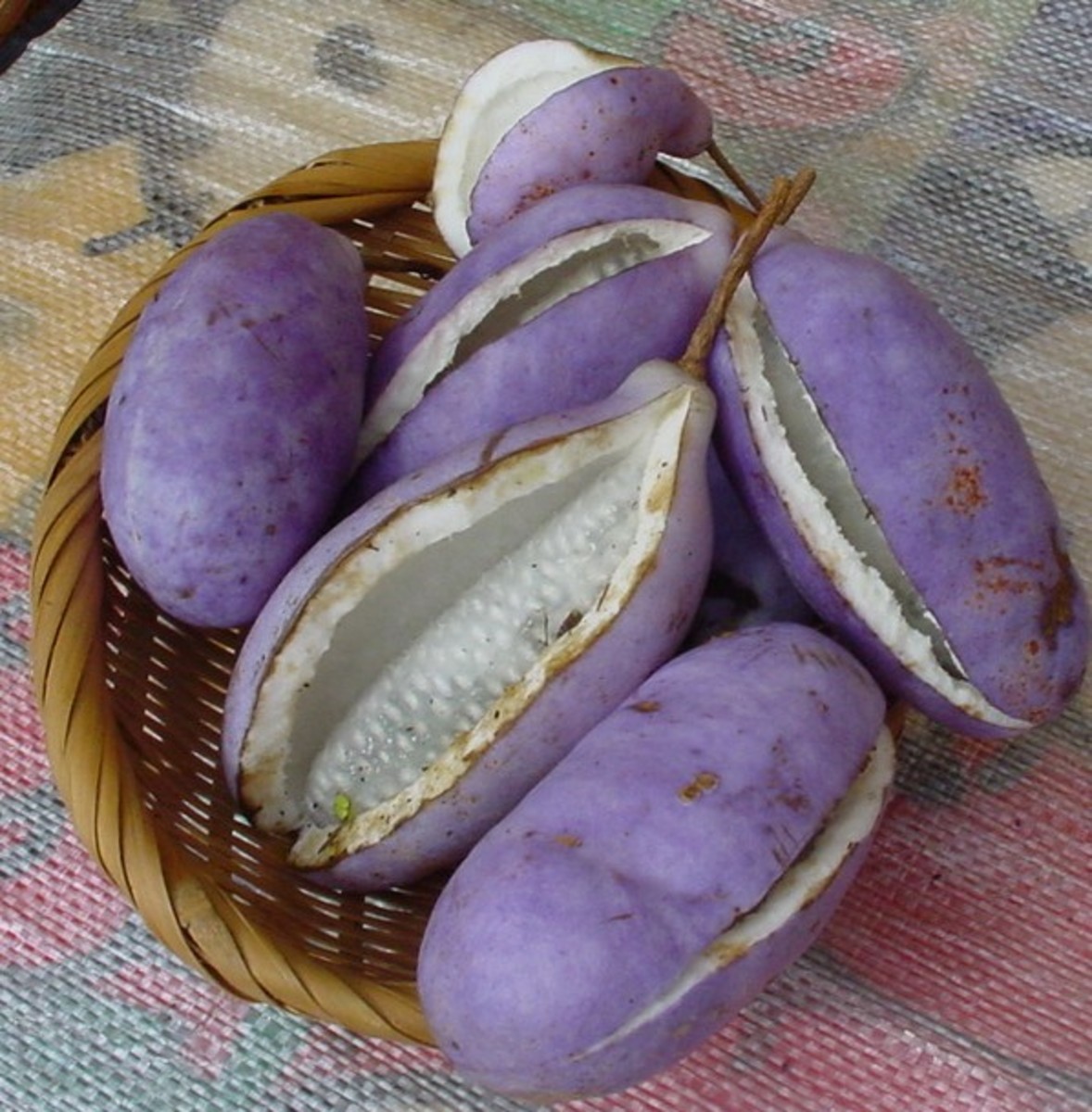
The Akebi fruit has a distinctive look. It has bright purple skin on the outside, and the inside flesh is white and elongated. It also contains many small black seeds that can be eaten while enjoying the flesh. Although the Akebi fruit is found in Taiwan, China, and Japan, it holds a special status in Japan, where locals love incorporating it into specialty dishes. The Akebi fruit has a soft yet crunchy texture when consumed, with a mild, sweet, and bitter flavor.
Ackee Tree Fruit
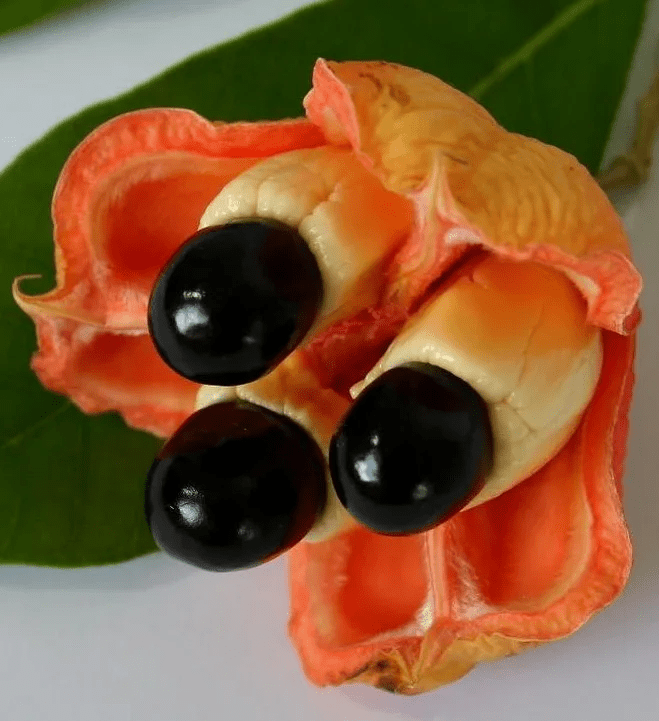
The Ackee fruit shown above appears just as it should when it is ready for use. Native to Jamaica, it is a delicacy in many Jamaican dishes. The image above shows the fruit when it is ripe. The fruit displays its seed protruding from the white flesh, which is the only edible part. The rest is extremely toxic. Indeed, Ackee fruit is also used as a vegetable, playing a significant role in Jamaica’s culinary scene.
The Fruit of the Cashew
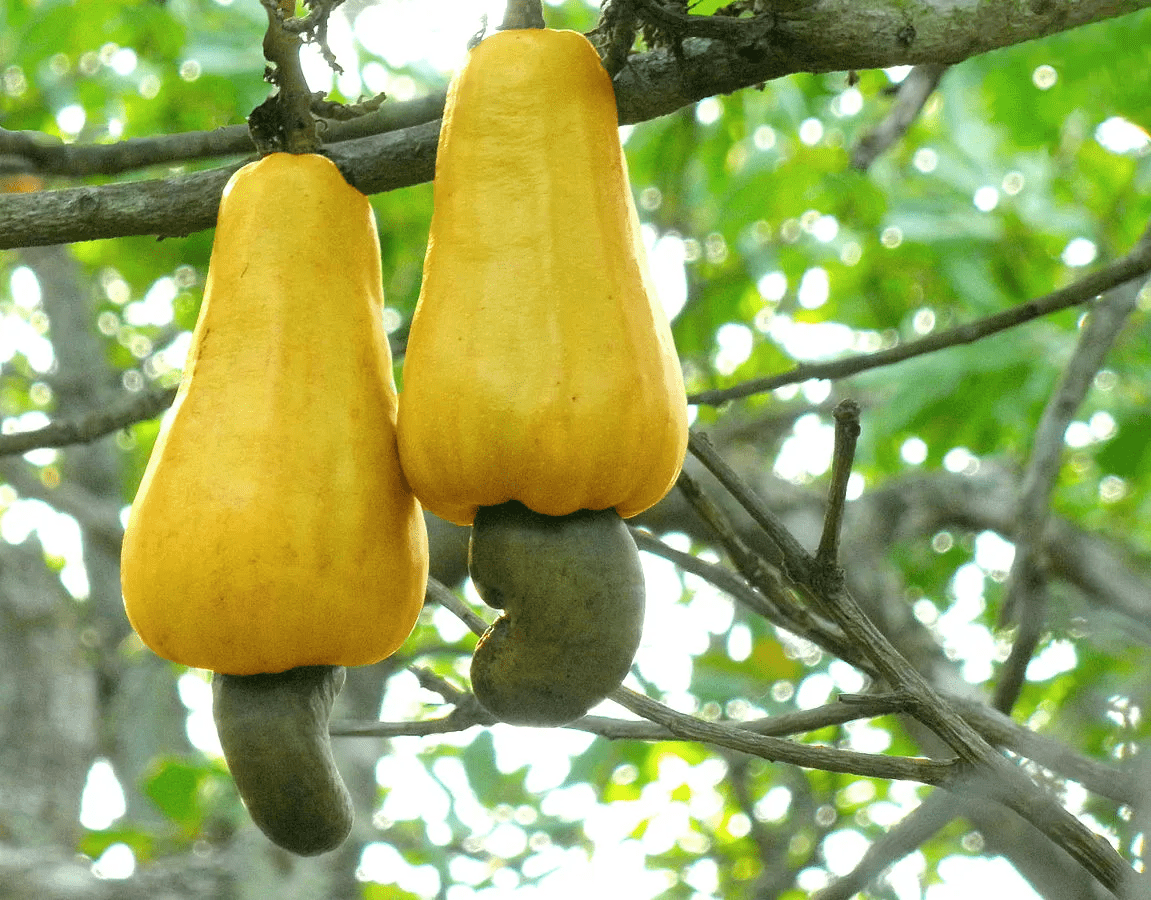
The most interesting aspect of this fruit is its appearance. What seems to be the fruit is actually a false fruit. If you’re not an expert, you might not notice this and could end up cutting the fruit incorrectly. The visible part that appears above is the seed, not the real fruit. The real fruit is the green or brown cashew-shaped protrusion. This is the main fruit that should be harvested. The commercial value of this fruit is mainly in the seed, which produces the dry fruit that almost everyone loves: the cashew nut.
Rambutan is a tropical fruit known for its hairy peel and sweet, juicy flesh.
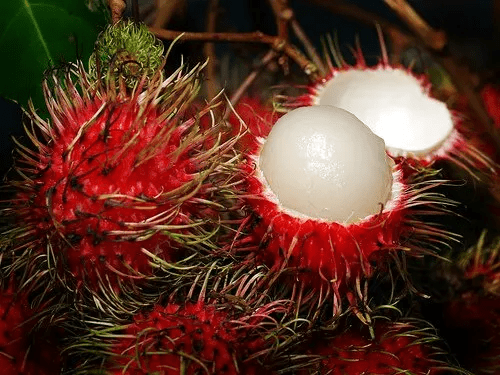
Rambutan is a local name frequently used in Malaysia and other Asian countries. The fruit is two inches long, with a pure white interior and a red, hairy exterior. As depicted in the picture above, the word Rambutan means “hairy” in Malay, which is why it is referred to as the “hairy fruit.” There are two well-known varieties of this fruit: yellow and red. When unripe, it is green, and as it ripens, it turns yellow or red. The skin of the fruit is easy to peel off and soft to the touch.
Mangosteen
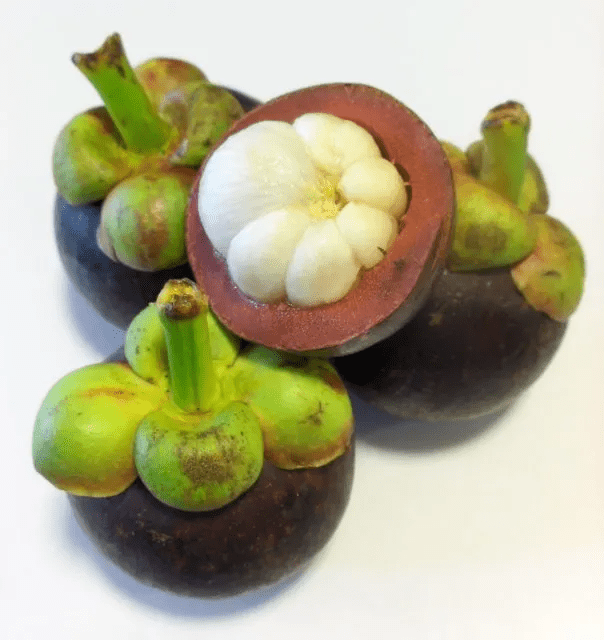
Mangosteen, the green fruit, is notable for its distinctive qualities. It is brown on the bottom, with a green flower-like stem. The fruit is small, about the size of a tennis ball, and its outer covering is deep purple and brown. This thick skin protects the white flesh inside. An intriguing fact about this fruit is that the number of petals on top indicates the number of arils it contains.
Kaffir Lime

Makrut Lime is quite different from other limes. Often referred to as ‘Kaffir Limes’ because of its historical background, it is a tropical fruit found in various Asian countries. It is the preferred lime for Thai people, who call it “Thai Limes.” Unlike other limes, Makrut Lime has a bumpy skin and a distinctively intense bitter taste that sets it apart. Its fragrance is very refreshing. In terms of similarities with other limes, Makrut Lime also has a green exterior, and its zest can be used as well. It contains a range of beneficial organic nutrients, making it valuable for both culinary purposes and herbal medicine.
Melothria scabra is known as Mexican sour gherkin.
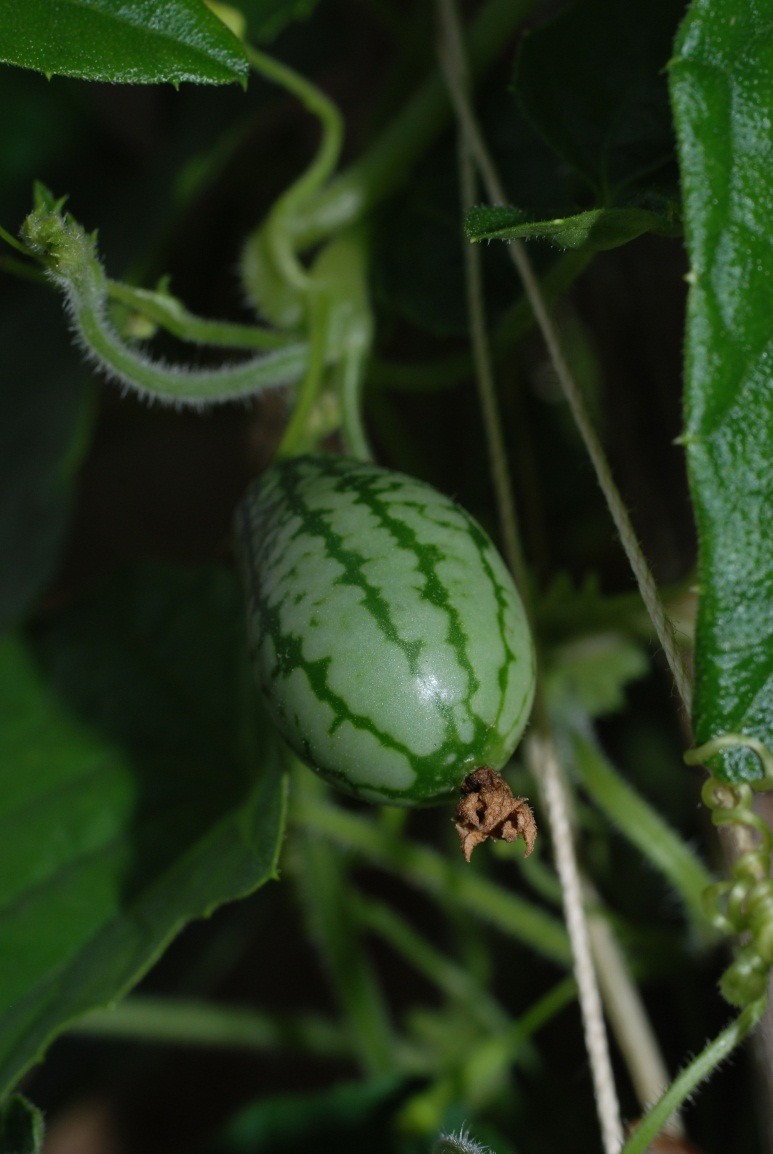
Melothria scabra, commonly known as Cucamelon, is part of the Cucurbitaceae family. This small fruit, similar to the Aboujahl watermelon, has a savory taste and a crunch reminiscent of cucumbers. It is rich in antioxidants, fiber, vitamin C, vitamin E, vitamin K, and potassium. Cucamelons are beneficial for those aiming to lose weight because they are high in fiber and low in calories. They contain lycopene, which is known for its anti-inflammatory properties, and help boost the immune system. Like cucumbers, Melothria scabra is light and can be added to salads.
Miracle Fruit (Synsepalum dulcificum)
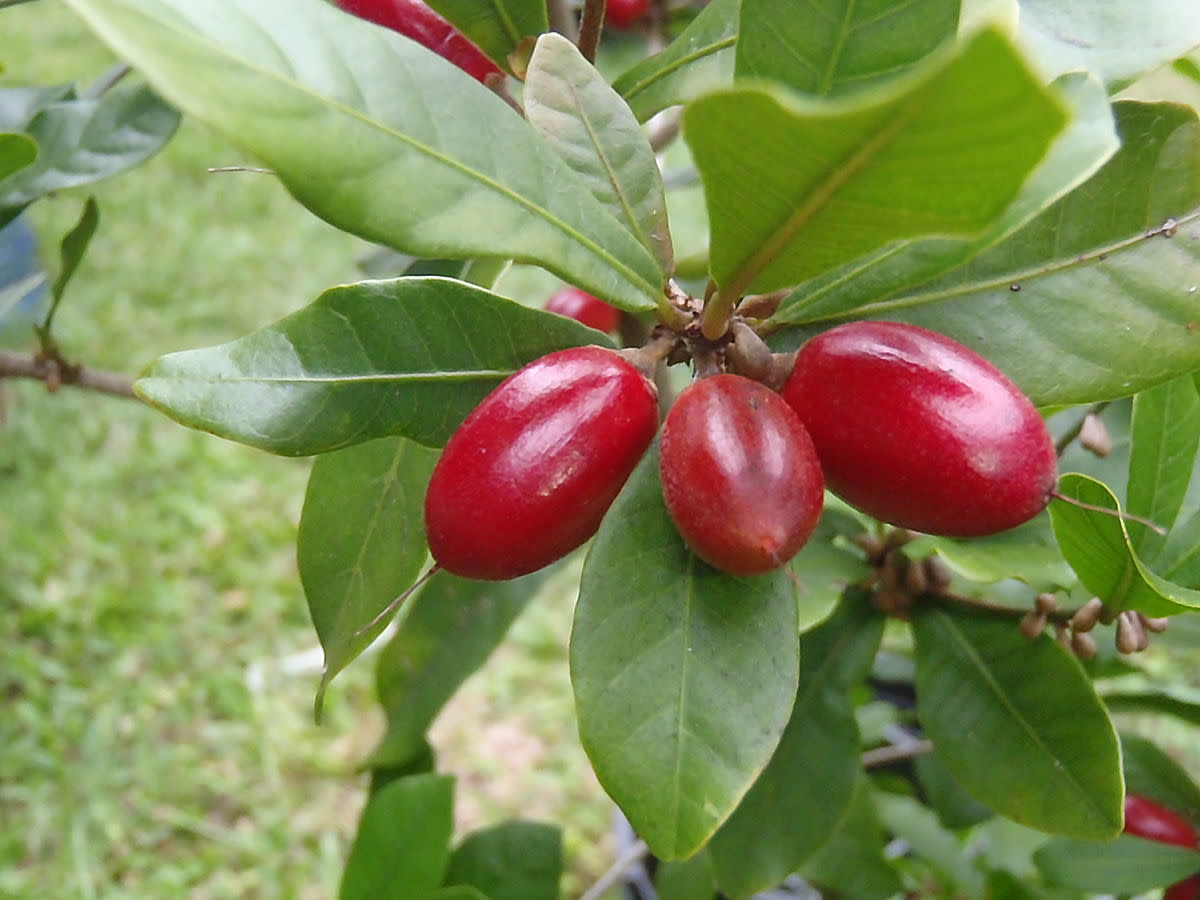
This fruit is called a ‘miracle’ because of its unusual side effect. After consuming it, you may find that even sour foods taste sweet. This is due to the miraculin in the fruit, which deceives our taste buds into perceiving sour as sweet.
Besides being an unusual berry, the miracle fruit is also used in herbal medicine to treat conditions like diabetes and to address taste distortions caused by medications. If you’re searching for miracle fruit, it is commonly available in West Africa, Ghana, Taiwan, and Puerto Rico.
The spiked melon (Cucumis metuliferus)
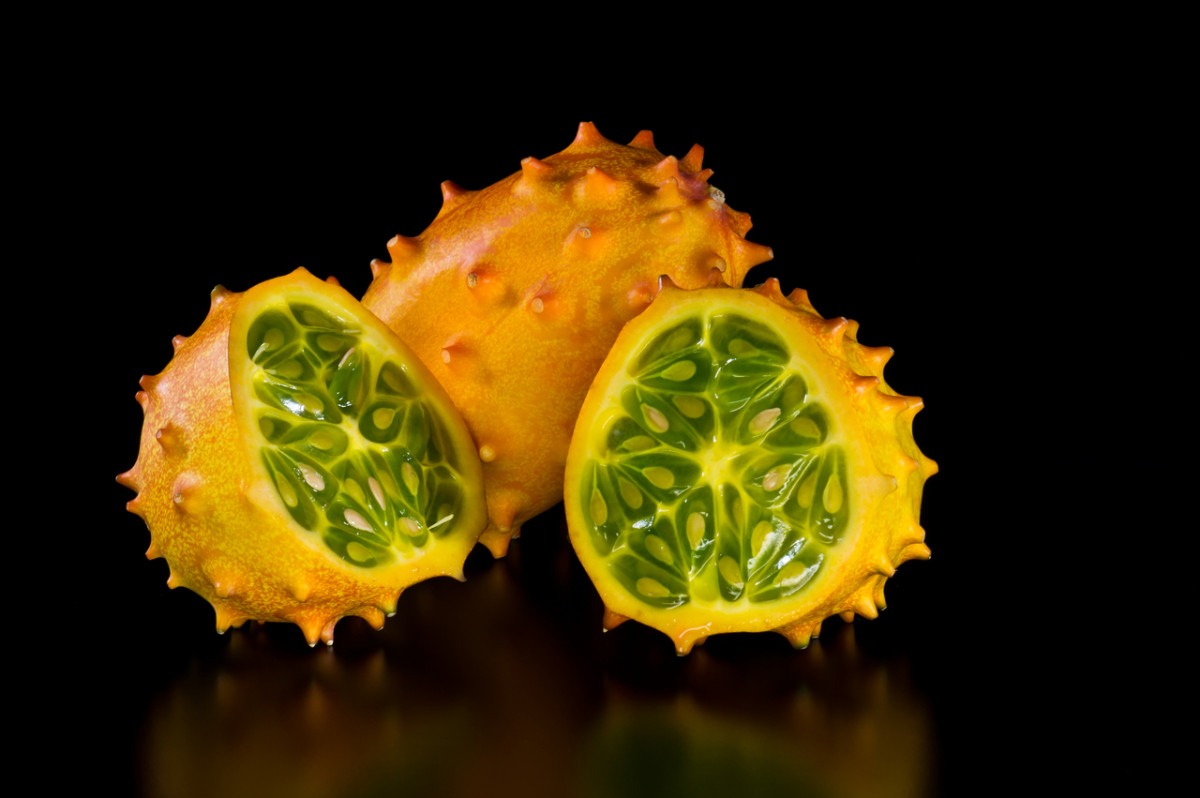
The African horned cucumber is a unique and exotic fruit. As it is part of the cucumber family, the Kiwano melon has a similarly mild taste, and it can sometimes be sweet. If the fruit is allowed to ripen fully, it can have a slight banana flavor.
The Kiwano melon was one of the earliest melons to be discovered in the world. Its yellow and orange skin, along with its distinctive texture, makes this exotic fruit a popular choice for use as an edible decoration on various food items.
The Aguaje Fruit (Mauritia Flexuosa)
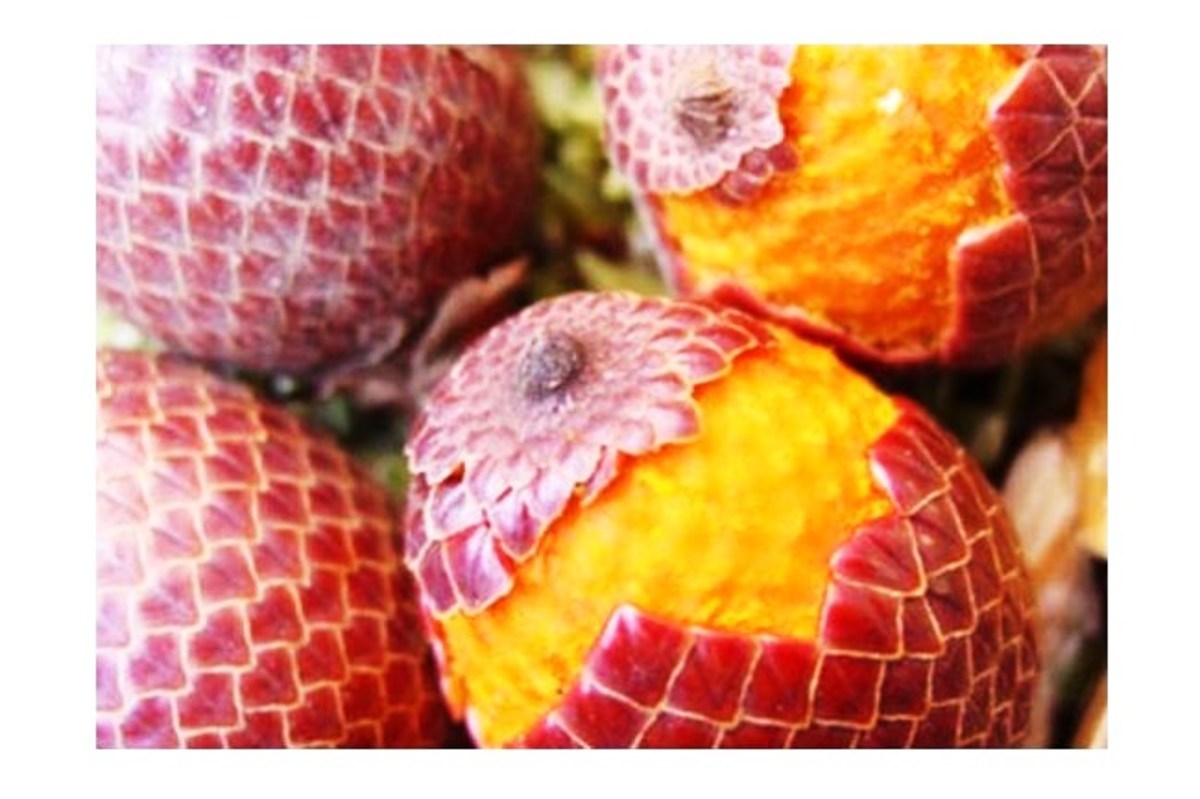
Cultivated in the tropical regions of the Peruvian Amazon, the Aguaje fruit has a unique appearance with its glossy brown scales. Once the skin is removed, it reveals yellow flesh with a nut in the center. Many people consume the Aguaje fruit for its variety of health benefits, including a high vitamin A content as well as antibiotic and anti-inflammatory properties.
If you’re seeking a fruit that can help maintain eye health and keep your skin looking fresh, the Aguaje fruit is all you need. Women are the most frequent consumers of this fruit, particularly because it is linked to enhancing the female figure.
Morinda Citrifolia (Noni Fruit)
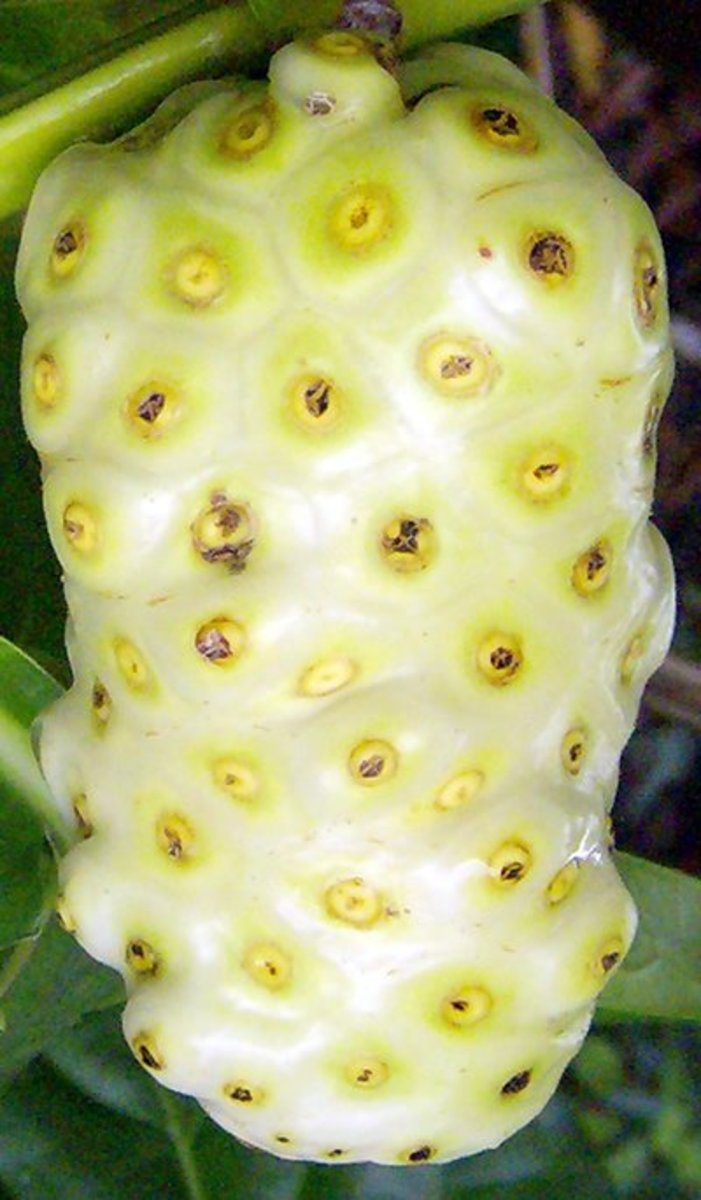
When it comes to the noni fruit, appearances can be misleading. Although its bumpy skin may seem strange to many, the health benefits of this fruit and plant are remarkable. Some modern health professionals have labeled it a superfruit due to its healing properties, including the ability to relieve menstrual cramps, bowel issues, urinary tract infections, and diabetes. Originally found in Southeast Asian regions, the unique Indian mulberry is becoming increasingly commercialized due to its medicinal qualities.
However, the noni fruit emits an unpleasant smell when ripe, earning it the nickname “vomit fruit.” To mask this odor, it is often cooked with spices that overpower the smell.
Breadfruit (Artocarpus altilis)
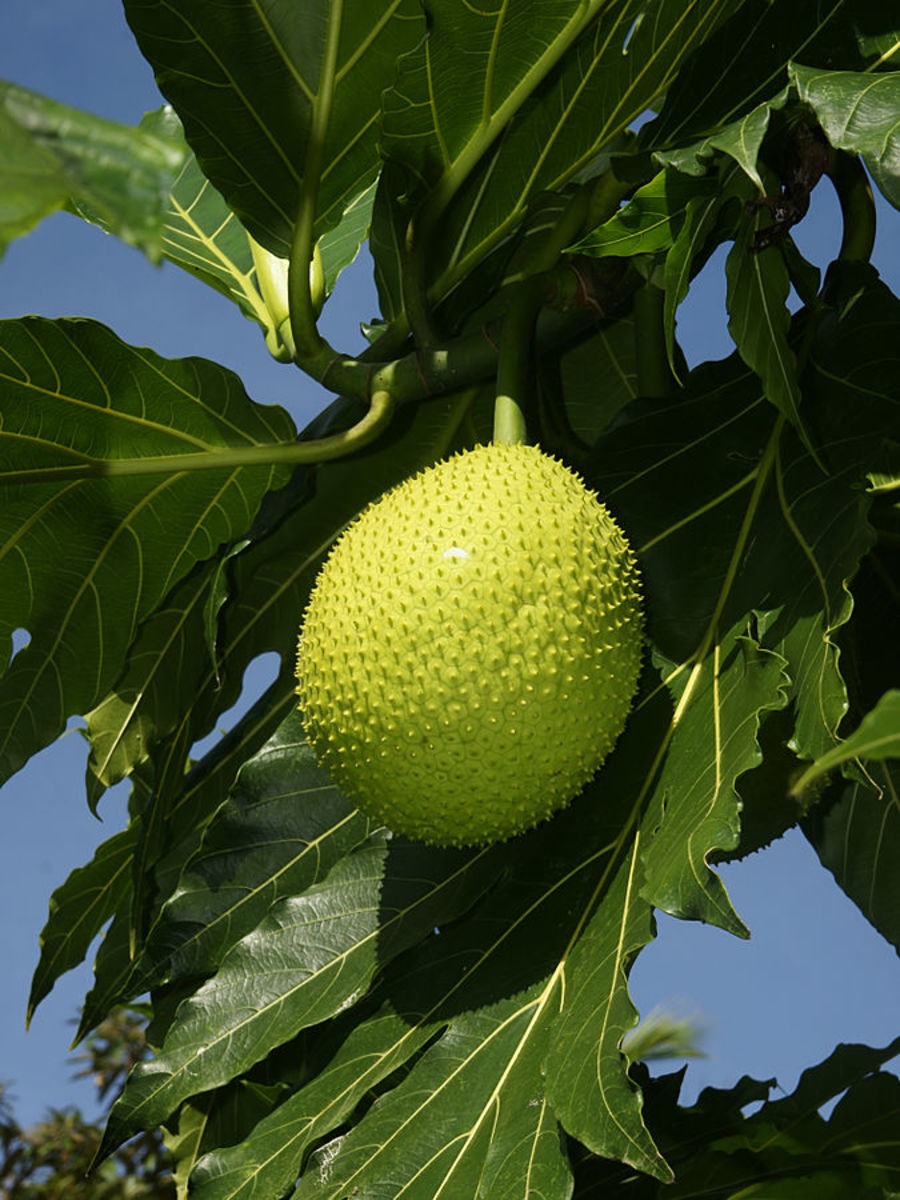
Part of the mulberry and jackfruit family, the breadfruit is commonly found in Southeast Asia and the islands of the Pacific Ocean. It is shaped like a melon and is roughly the size of a standard soccer ball. Its outer skin is bright green with a textured surface. When peeled, the inside reveals flesh with seeds in the center.
As the breadfruit ripens, the natural starch in the fruit begins to turn into sugar. If you cook it, you’ll notice it tastes similar to freshly baked bread. We suggest trying it with both savory and sweet dishes since the breadfruit can be a great neutral addition to your meal.
Cape gooseberry (Physalis Peruviana)
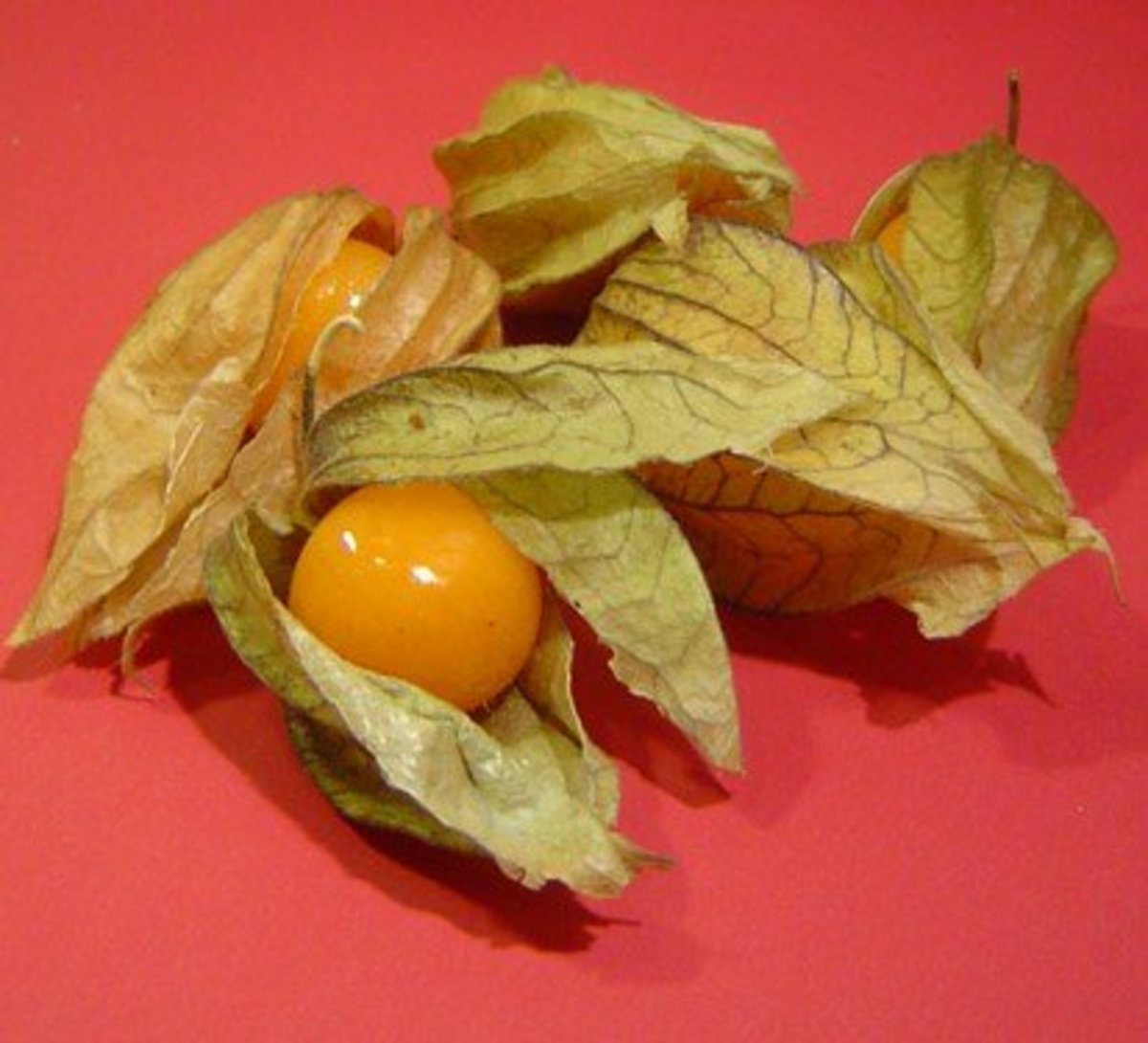
Physalis fruit, also called the golden strawberry, looks like a tiny tomato. The fruit is so small that when it grows within the papery husk, it is often hidden and looks like a bougainvillea flower. To discover the Physalis fruit, you need to remove the husk.
When it is ripe, Physalis has a flavor somewhat like pineapple. Its sweet-tart taste makes it suitable for eating raw, cooking, or turning into jellies and jams.
Fruit of the dragon
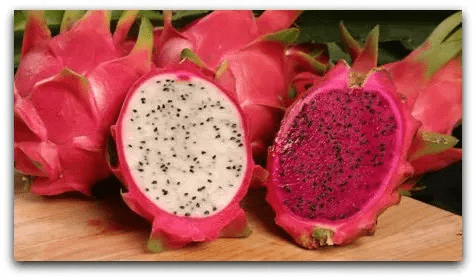
When you look at this fruit, you understand that its name is fitting and ideal. Its vibrant red color is stunning and reminds one of a dragon’s tail. The interior flavor is sweet and comes in two different colors: red and white. The red and sometimes purple interior is much sweeter compared to the white one, though the outside of both looks the same. The outer skin isn’t hard to remove, and the edible seeds inside create a taste as sweet as the fruit itself. Dragon fruit belongs to the cactus family.
Custard Apple
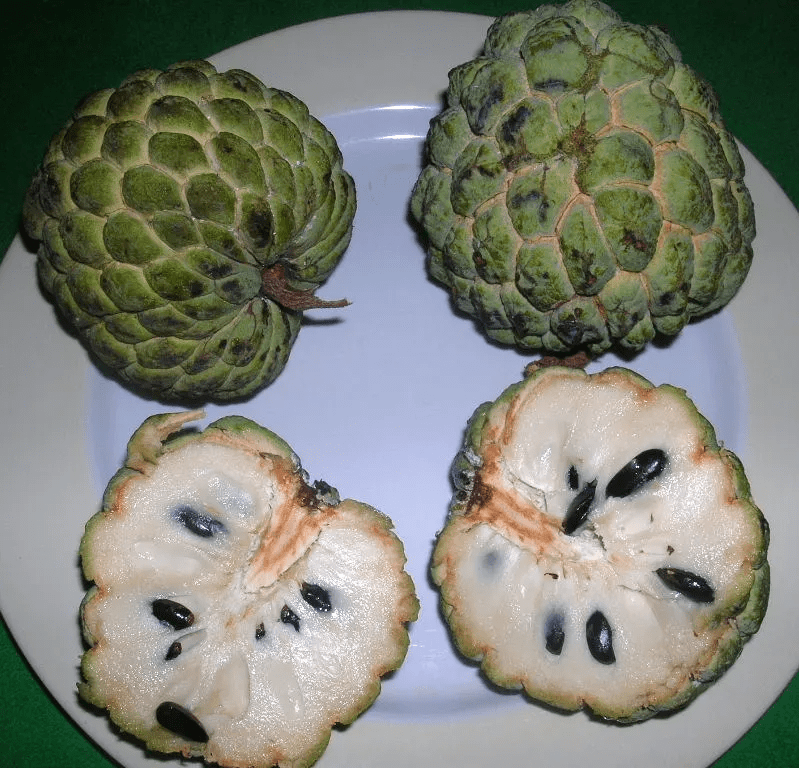
The Custard Apple is quite an intriguing fruit. It’s referred to as a green apple due to its appearance. Externally, it resembles a green apple with bumps that might have developed over time. The fruit is soft to touch and easy to open, revealing the sweetest white flesh you may ever taste. The fruit’s interior is white with black seeds. You can also remove the bumps from the skin, with some pulp coming away with the peel. It originates from the Andes and is a unique fruit that is rare and hard to come by.
Cupuassu
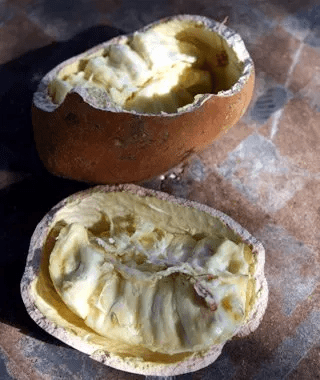
The Cupuacu, as shown in the image above, is a distinctive fruit native to the Amazon basin. It has a brown color and an oblong shape. The fruit’s hard shell protects the interior. Overall, it measures around twenty centimeters in length and can weigh over one or two kilograms. Inside, the fruit’s flesh is soft and white. Cupuacu is excellent for boosting immunity and for revitalizing skin and hair.
Durian is a tropical fruit known for its distinctive odor and thorn-covered husk.
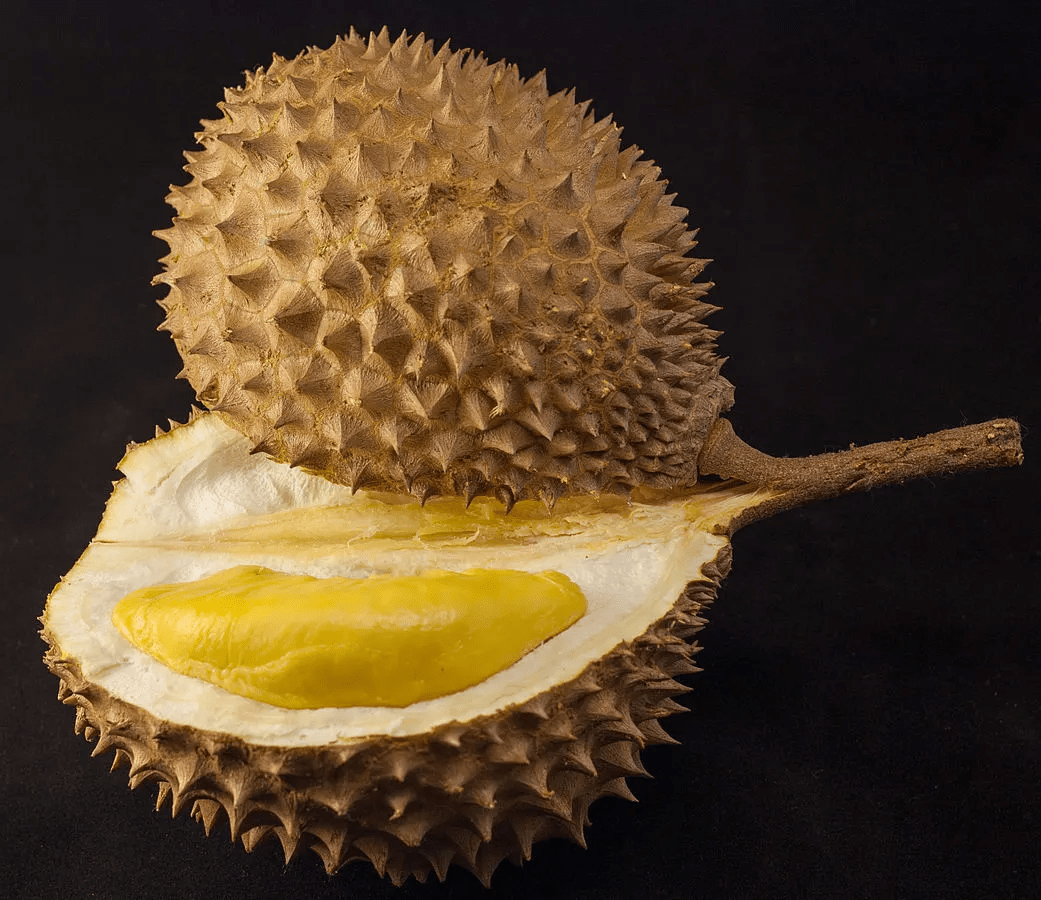
You might be familiar with Durian, a fruit notorious for its unpleasant odor, which has led to it being banned in many locations. Many consider it the strangest fruit primarily because of its smell. Durian is predominantly found in countries such as Malaysia and Singapore. It has a spiky exterior that safeguards the tender fruit inside. The odor of this fruit is the main issue. In Singapore, the government has prohibited the fruit in public areas due to its smell. However, the flesh inside is as sweet as honey nectar, suggesting there might be something good about it.
Jackfruit
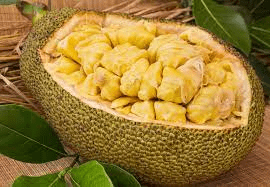
Jackfruit, mainly found in India and Malaysia due to declining production, is now rare. As depicted in the picture above, its exterior is hard like that of a pineapple and has small bristles that protect the fruit inside. Inside, you’ll find individual fruits that are light yellow in color and resemble dumplings. The best aspect of jackfruit is that it tastes like meat, which is why it is referred to as vegetable meat. It is used in South Asian and Malaysian cuisines as a substitute for meat by vegetarians and vegans. The quantity of fruit within the shell is remarkable.
Melon from Korea
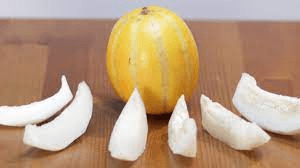
The Korean Melon, shown in the picture above, is grown primarily in Asian countries. It is thought that the melon journeyed from India and Pakistan along the Silk Road to China and eventually to Korea. The fruit has a sweet flavor, which some describe as a cross between honeydew and cucumber. It has a texture that is easy to slice and open. The thin skin and the small seeds make it easy to eat the whole fruit. You can even avoid peeling it if you prefer.
Passionfruit
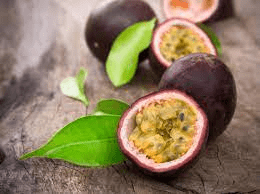
Passion Fruit comes from the passionflower plant. It’s easy to recognize with its tough outer shell, typically dark purple or brown. Inside, there’s a layer of juicy white material, and beyond that is the actual fruit, which is yellow and filled with seeds. Originally a tropical fruit, it’s now widely available worldwide thanks to advances in agricultural technology. The fruit is very nutritious, providing an excellent source of fiber and various vitamins.
Feijoa is an evergreen shrub or small tree native to the highlands of southern Brazil, parts of Colombia, Uruguay, Paraguay, and northern Argentina. Known for its edible fruit, it is also called pineapple guava or guavasteen and is grown in various regions around the world for its sweet, aromatic fruit that resembles the flavors of strawberries and pineapple.
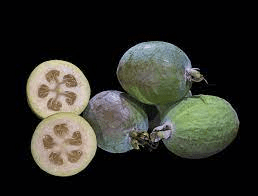
Feijoa is a fruit that usually grows on what is known as the ornamental tree, due to it being an evergreen tree. This fruit belongs to the guava family, although it is not exactly a guava. Its appearance includes a green exterior, with skin robust enough to endure external temperatures, as it is cultivated in dry to mildly dry areas. The tree gets the name “ornamental” because of its beautiful leaves that form an artistic-looking plant. The fruits can be processed to make jam and can also be eaten fresh, as they have a sweet taste.
Tamarillo
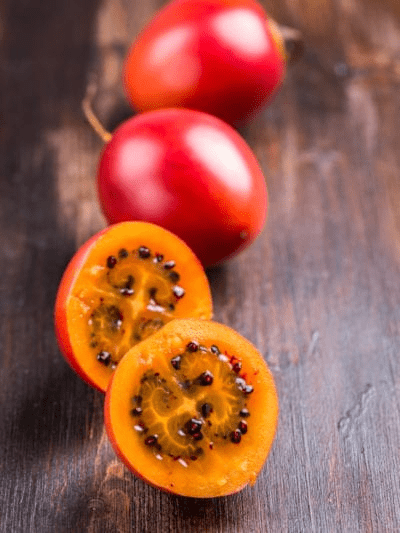
The tamarillo is a fruit that looks similar to a commonly used vegetable called the tomato. However, despite its appearance, it should not be mistaken for a tomato. This small, almost duck-sized fruit is orange-red in color and is grown in many warm regions, such as Central to Latin America, where it can endure high temperatures. Although the skin of the fruit is often considered edible and recommended to be eaten, the interior is juicy and contains seeds that are safe to consume. Tamarillo is commonly used in chutneys and other food condiments.
Tart Plum
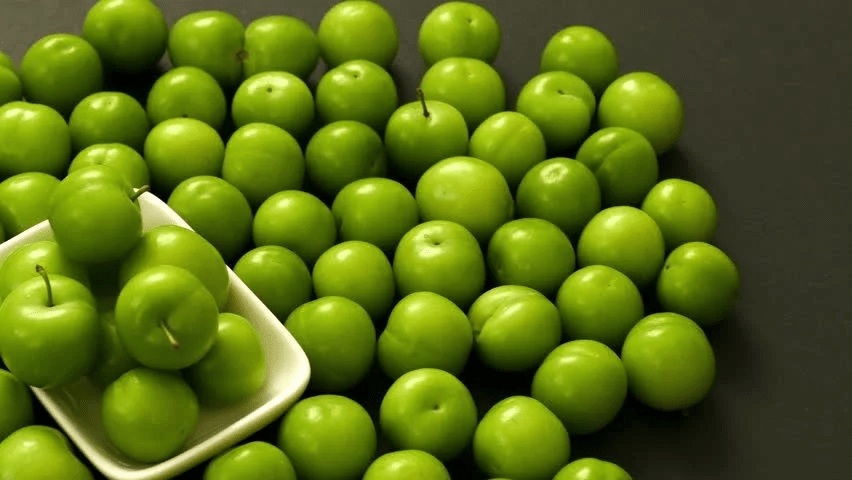
Sour plums are recognized globally, predominantly exported from Iran to other countries. They are small and green, resembling little apples with taut, fresh skin. Naturally sour, these plums make an excellent palate cleanser. Consuming them with a pinch of salt can help refresh your taste. They are commonly used in chutneys and are sometimes enjoyed straight from the tree. These plums can be eaten alone or as a snack since their small size means they won’t fill you up.
Beans that taste like ice cream
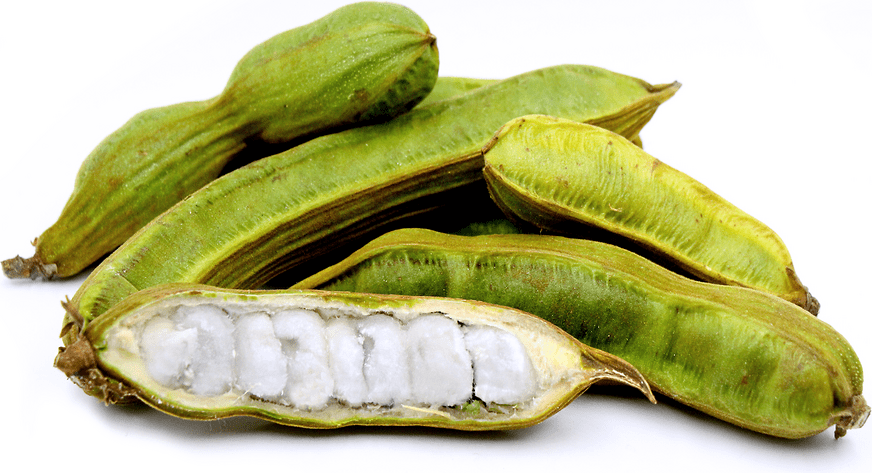
Ice cream beans are among the most distinctive fruits from South America. Although the exterior resembles peas, they have a very sweet vanilla flavor. When you peel the outer layer, the inside is white and has a texture similar to cotton candy. After trying them, you’re likely to want to have them again.
Longan is a tropical fruit related to the lychee and rambutan, known for its sweet and juicy taste.
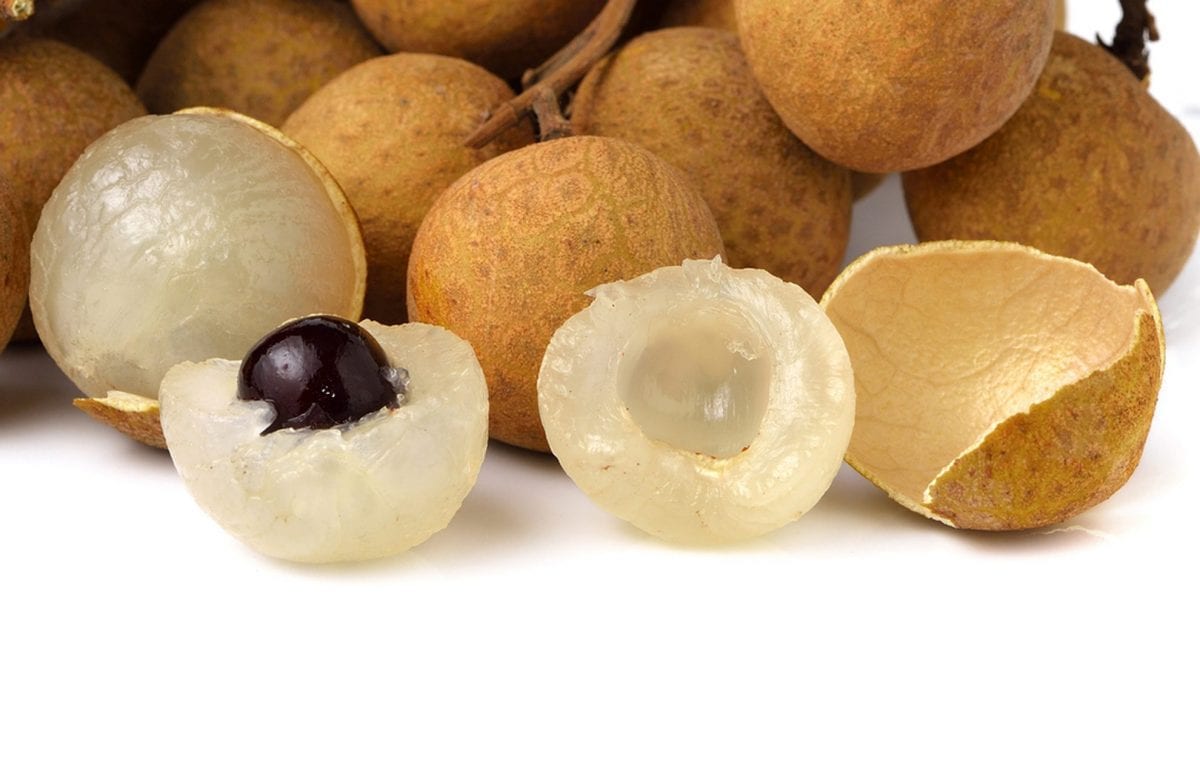
Dimocarpus longan, commonly known as longan, is a tropical tree in the Sapindaceae family. The tree is native to Asia and surrounding regions. It bears an edible fruit with a brown, leathery exterior enclosing a white, jelly-like translucent pulp. This pulp contains a single dark seed. The fruit of the longan is spherical and is typically harvested in large clusters.
It closely resembles lychee and is available either dried, in its raw form, or canned in syrup. Its taste is similar to dates, making it popular in sweet and sour dishes. Additionally, longan is widely used in traditional eastern folk medicine.
Mulberries are a type of fruit.
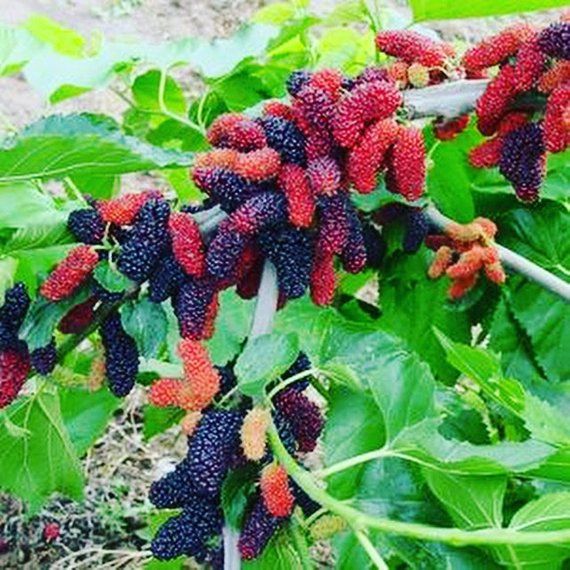
Morus Alba is a fast-growing mulberry tree with a lifespan similar to that of humans. While native to China, it has become naturalized in countries like America, Australia, Turkey, Iran, and India. This medium-sized tree produces edible berries, which are typically black, white, or red. It is commonly referred to as the silkworm mulberry because it is extensively used in silk production.
Mulberries are valued as ornamental plants due to their vibrant and attractive appearance. Their sweet flavor makes them popular for making wine, tea, jam, juice, and processed foods. Additionally, it is an effective component in traditional Chinese medicine, known for its ability to reduce high cholesterol levels and stress, thanks to its bioactive compounds.
Jujube
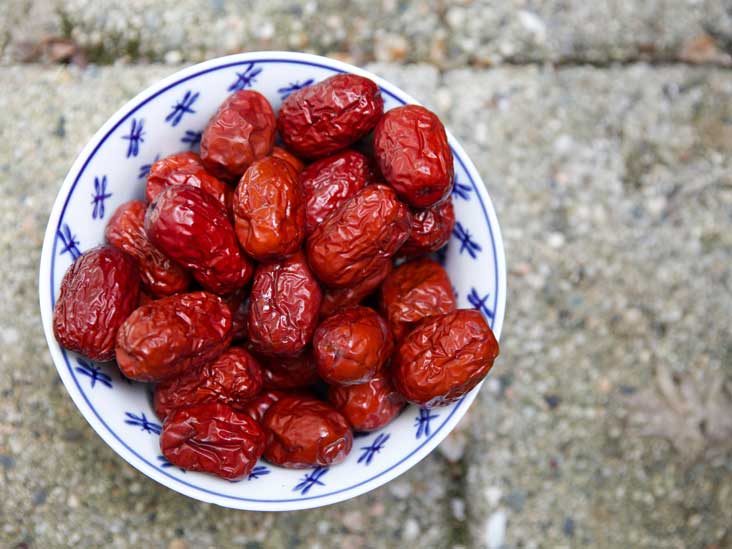
Commonly referred to as a red date or Chinese date, this is a small reddish-brown fruit with a wrinkled exterior. It grows on the Ziziphus jujuba plant, which is native to Southern Asia. The fruit initially resembles green apples when unripe but looks more like a date as it matures. Their sweet taste and chewy texture make red dates popular in candies and desserts. In traditional medicine, jujube fruit is often used to enhance sleep patterns and cognitive brain functions.
Salak is a type of fruit also known as snake fruit because of its reddish-brown scaly skin.
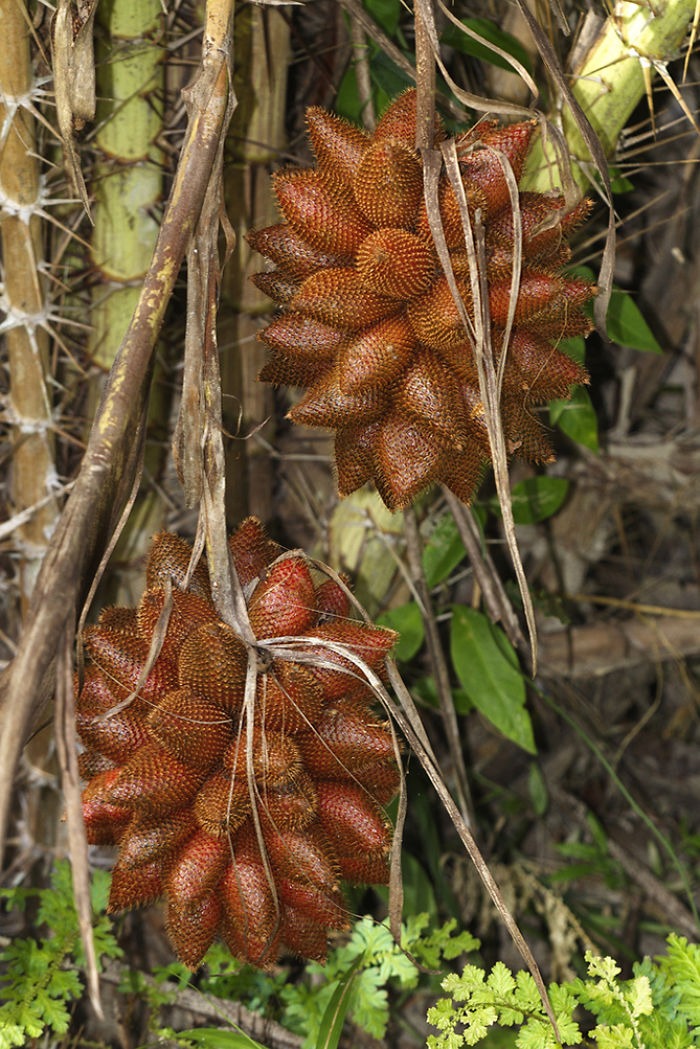
Salacca Malacca, scientifically named, is part of the palm tree family. This fruit is naturally grown in Indonesia’s Java and Sumatra regions. It is often referred to as snake fruit due to its reddish-brown, scaly exterior. The fruit grows in clusters at the base of the palm. The part typically eaten by humans is the white pulp. Inside, it is divided into three sections, similar to garlic cloves, which are exposed when peeling away the scaly skin. This fruit offers numerous health benefits, such as enhancing stamina, boosting brain activity, among others.
Starfruit
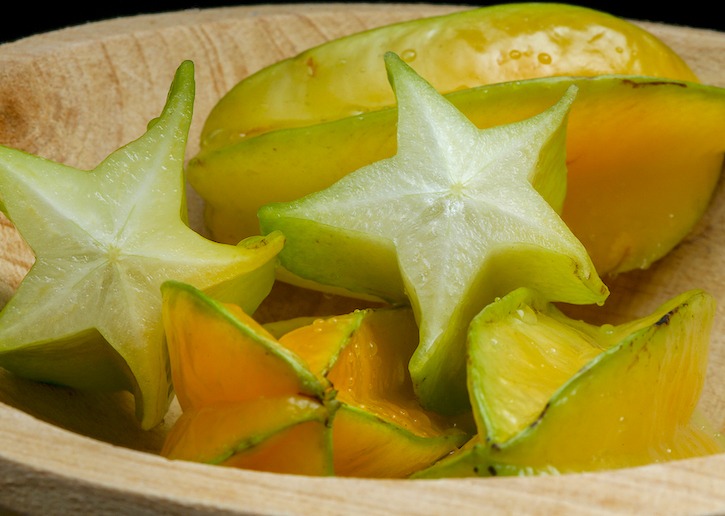
Some of you might have tried the sweet and sour star fruit known as carambola. Although it has a sour taste, did you know that this fruit is an excellent choice for your health? It is a highly nutritious fruit that boosts antioxidant levels whenever you eat it. You might be surprised to learn that Carambola is just the scientific name. The fruit is star-shaped, which is why it’s commonly called star fruit. It is typically a greenish-yellow fruit that is crispy on the outside, and the sourness is more tart. The fruit is not only healthy for your body but also highly beneficial for enhancing your beauty.
Be sure to enjoy the tart star fruit and don’t miss out on experiencing the benefits!
Violet Yam
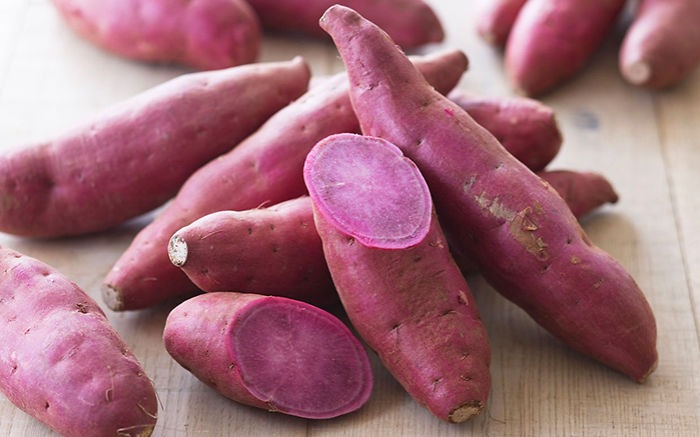
There’s always an ongoing debate about whether sweet potatoes are fruits or vegetables. You should believe that sweet potatoes are a beloved vegetable!
Not only are they tasty as a side dish with every meal, but they also offer excellent nutrition for your body. They help increase beta-carotene, which protects against heart disease. Additionally, they boost your immunity and ensure proper blood circulation.
Furthermore, the beautiful purple sweet potatoes are rich in anthocyanin, which helps maintain brain health. As a result, they are very beneficial for patients with dementia.
Black Sapote
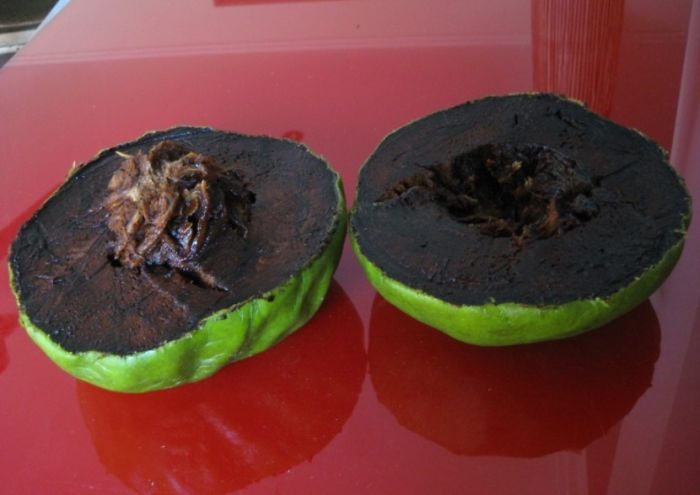
Black Sapote is often referred to as chocolate pudding fruit, black soap apple, or zapote Prieto in Spanish. This tree that produces tropical fruit is native to Mexico, Central America, and Colombia. The black Sapote resembles a tomato in size, shape, and some physical characteristics. Its olive-colored skin becomes yellowish-green when ripe. Similarly, the unappealing white pulp transforms into a distinct chocolate pudding-like flavor as the fruit matures. Black Sapote is highly unsuitable for eating in its unripe form. Because of its chocolate-like taste, it is widely used in baking cakes, making ice cream, mousse, and other confectionery products.
Lychee
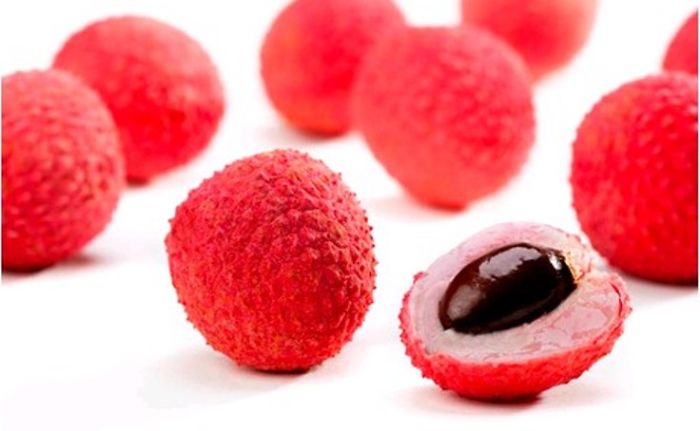
Did you know that Litchi is referred to as the Chinese fruit? While it is cultivated in China, it is also found in countries with warm climates like the USA, Hawaii, and Florida. Its shell or skin has the intriguing nickname “alligator strawberry” due to its red, strawberry-like textured skin.
One of the most remarkable aspects of litchi is its delightful fragrance! It has a floral aroma paired with a tasty fruity flavor. You can enjoy litchi in a smoothie, in salads, or simply savor the fruit on its own! There’s no denying that peeling litchi can be a bit challenging. However, the effort is definitely worth it!
Achiote
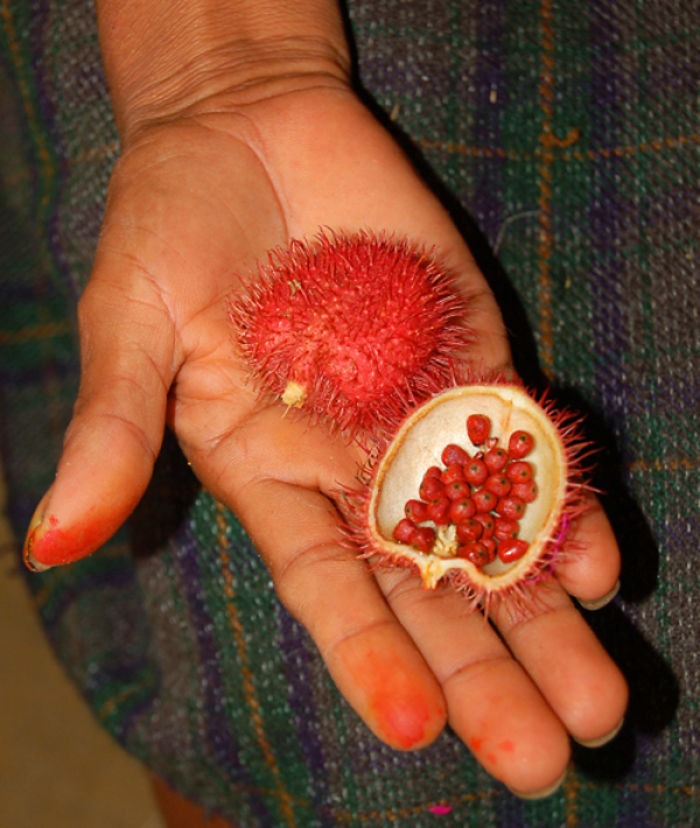
Achiote, also known as annatto, is an orangish-red spice made from the seeds of the Bixa Orellana plant. The achiote tree is commonly cultivated in tropical regions stretching from Mexico to Brazil. It is used in cooking as a natural food coloring due to its ability to give foods an orange or red hue. The spice has a slightly peppery taste with hints of nutmeg, resulting in a sweet, nutty, and peppery flavor. Annatto is frequently utilized as a coloring agent in the large-scale production of dairy-based packaged foods. Furthermore, it serves as a safe and organic alternative to synthetic food colorings, helping to prevent food-related allergies.
Langsat Fruit

Langsat fruit, known as Lanzones in English, Dokong in Malaysia, and Duku in Indonesia, is part of the Mahogany tree family. Scientifically, it is called Lansium Parasitiucum. This sweet, delicious oval-shaped fruit originates from Southeast Asia, including Malaysia, Thailand, Brunei, and the Philippines. It has soft, bitter seeds that give Langsat its sour taste. This seasonal fruit grows in clusters like grapes and is picked in late autumn and early winter when it takes on a yellow-brown outer appearance. Similar to longan and lychee, Langsat has a translucent, gel-like flesh and a slightly acidic flavor. It provides essential nutrients such as fiber, vitamin A, and antioxidants, and contains only 57 calories per 100g.
Papayas from Hawaii
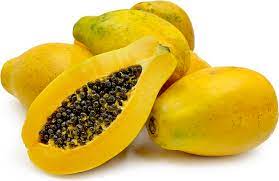
Hawaiian Papayas originally come from the southeast side of Central America. Once introduced to other countries worldwide, Hawaii became the leading exporter, supplying 90% of Hawaiian Papayas. This small, pear-shaped fruit has a bright greenish-yellow skin. Its fragrant, flavorful flesh is golden yellow in color, with a taste blending peaches and mangoes. The fruit also contains numerous black seeds, which are edible and give the fruit a spicy flavor. Hawaiian Papayas are available year-round and are rich in vitamin A and antioxidants. They also aid in digestion.
Sapodilla

Sapota, also known as Sapodilla and referred to as Chikoo in several Asian countries, is originally cultivated in the southern regions of Mexico and Central America. This brown, oval-shaped, soft fruit is available twice a year. It is harvested in mid-winter and at the end of spring. The yellowish-brown flesh of the fruit is sweet and contains 2-3 large inedible black seeds. Sapotas can typically be stored for up to three days at most, as they spoil easily. It is a good source of fiber, acting as a laxative, and is rich in Vitamins C and A. In addition, it boosts your immunity.
Kumquats

Kumquats are among the oldest fruits, originally from Southeast Asia. These small, oval-shaped fruits are orange in color and are part of the Rutaceae family. The fruit’s skin is thick and clings tightly to the flesh through a tasteless pith. The fruit consists of 4-6 segments that contain small seeds. The entire fruit is edible, with a sweet peel and slightly sour flesh that complement each other in taste. It is a versatile fruit and is commonly used as an herbal ingredient in many remedies due to its beneficial nutrients, including iron, calcium, zinc, vitamins A, E, C, and various essential oils.
Watermelon Radish
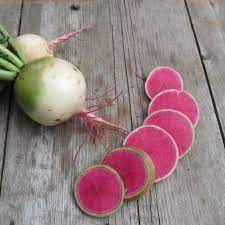
Watermelon Radishes originate from China, where they are commonly known as Shinrimei Radishes. This smooth, round, white fruit consists of edible roots. Inside, it has a striking magenta-colored flesh that is slightly savory and crisp in taste. Its size varies depending on whether it is harvested in late autumn or spring. When consumed raw, the entire fruit is rich in Vitamin C. It contains a chemical compound called Isothiocyanate, which classifies it as organic. This watermelon can also be served cooked. The Chinese often cook it with seafood to enhance its sweetness.
Ugli fruit
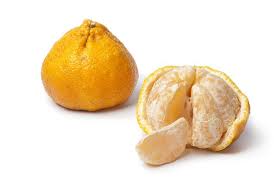
Ugli Fruits are quite sizable, with a diameter of roughly 13 cm. These citrus fruits were first discovered on a random tree in Jamaica in the early 20th century. They have an irregular shape, and their thick, easily removable peel is somewhat bumpy with some marks on it. As they ripen, the fruits display a mix of green, yellow, and orange hues. Inside, the fruit is divided into 10-12 segments, each separated by membranes. The yellowish-orange flesh emits a lemon-like fragrance and has a sweet taste reminiscent of both oranges and grapes. High in antioxidants and vitamin C, these fruits enhance your immune system and help reduce inflammation.
Carrots that are purple in color
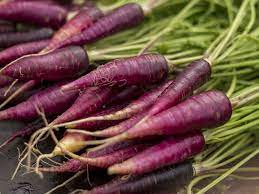
The striking magenta-colored carrots have their origins in the region of Afghanistan, Turkey, and several Middle Eastern countries. They display beautiful shades ranging from dark violet to purplish-red. These carrots have a peppery flavor. Purple carrots are typically magenta and white in color. They contain a wide variety of nutrients that offer significant health benefits. All types of carrots are rich in antioxidants, fiber, manganese, potassium, vitamin C, and have high beta carotene content that protects against inflammations and infections. Additionally, they are low in calories. They also contain anthocyanins, compounds that prevent heart clotting, thus protecting against cardiovascular disease.
Kepel Fruit
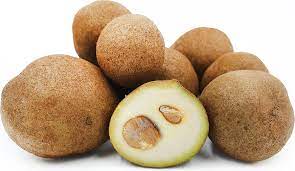
Kepel Fruits, native to Southeast Asia, belong to the Annonaceae family. They range in size from small to medium. Their exterior has a rough, leather-like texture and changes color from green to brown as it matures. The flesh is creamy and smooth. Remarkably, it remains fresh for six months. A ripe fruit is indicated by its brown surface being easily scratched. Kepel fruits have a very sweet aroma, similar to mangoes and papayas. Like other fruits, they are rich in vitamins C and A. In Asian countries, Kepel fruits are used as anti-aging agents and for cleansing the kidneys.
Jicama
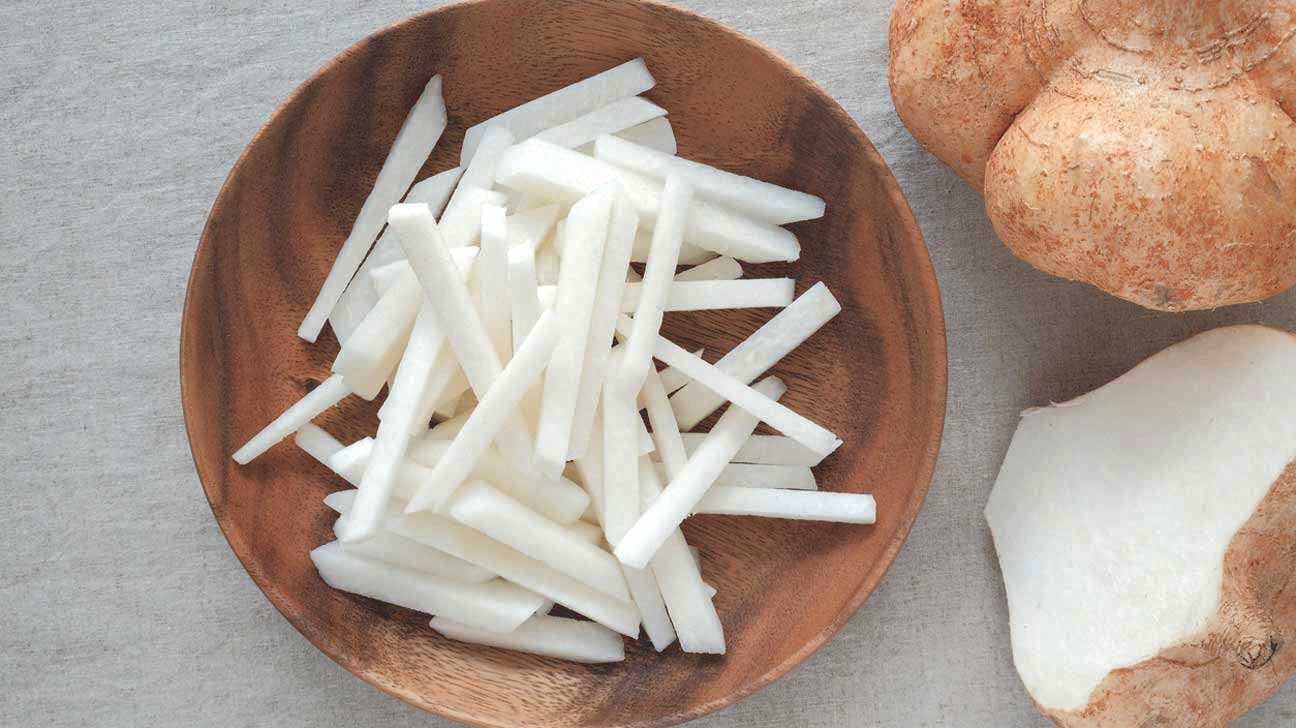
Jicama, commonly referred to as Yambean in Mexico and South America, originates from those regions. It is an oval-shaped vegetable similar to legumes and comes in various sizes. Much like potatoes, it has a rough, brown, textured skin, and its taste is reminiscent of chestnuts. Jicama is available year-round. The outer skin is thick and can be easily cut with a knife, though peeling it is more challenging. It is more beneficial when consumed raw. You can easily store it in the refrigerator, as it typically does not ripen.
Gac Fruit
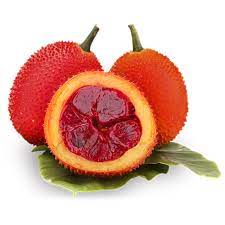
These melon-sized fruits are found in several regions of Southeast Asia and are native to Vietnam. Initially green, they turn orange as they ripen. The round-shaped Gac fruits can be up to 13cm in diameter. The skin is spiny, whereas the interior contrasts with its soft, spongy orange-colored flesh. Inside, there are edible magenta-colored sacs. What a beautiful fruit it is! They are not very sweet and are available in autumn. This fruit is rich in lycopene and beta-carotene, which are also present in tomatoes and potatoes, respectively.
Aboujahl melon
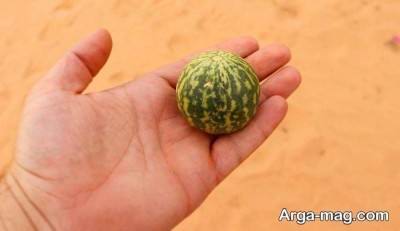
Aboujahl watermelon is part of the Cucurbitaceae family, a group of flowering plants. It was initially discovered in Africa. This type of watermelon is small and resembles a modified berry. It shares all the typical features of a watermelon, including its exact taste. It has a tough outer rind and a sweet, smooth red interior. The main difference is its smaller size, making it a miniature version of watermelons. While we are all familiar with the delicious and refreshing qualities of watermelon, the Aboujahl watermelon stands out as one of the most unique experiences. It’s composed of water and fiber, which makes it a great choice for those following a diet.
Bananas that are red in color
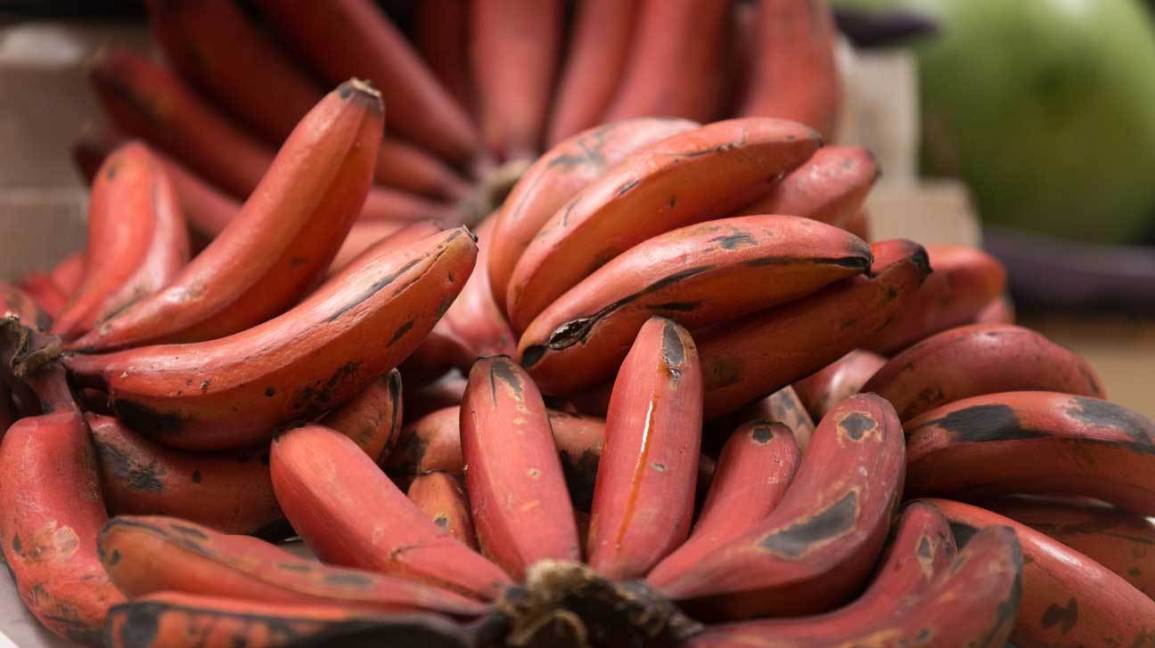
Red bananas are more nutritious than yellow bananas and were first discovered in Asian countries. They are available year-round, similar to yellow bananas. They typically have a slightly dry taste, so it’s best to wait until they’re fully ripe. Once ripe, they have a thick, deep brick-colored peel and soft, sweet flesh that tastes like raspberries. Red bananas contain more beta carotene and vitamin C compared to yellow bananas. They also have all three types of sugars present. Like other bananas, red bananas can be used to make shakes, sweet desserts, and baked goods.
Prickly pear
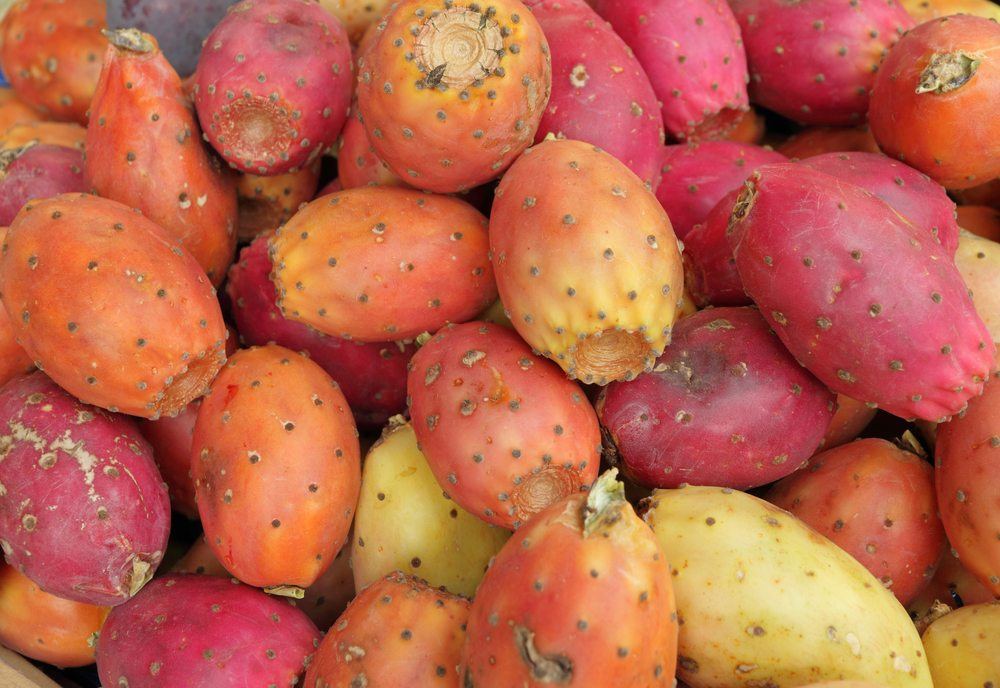
While most cactus fruits around the world aren’t fit to eat, this one stands out. These are pears with a prickly exterior. Fortunately, in the market, they’re sold without the spines. The spines are removed before the fruit is sold. However, if you encounter one in the wild, they can be quite challenging to eat with the spines still on. The fruit is tasty and nutritious on its own, though most people still opt to drink its juice.

